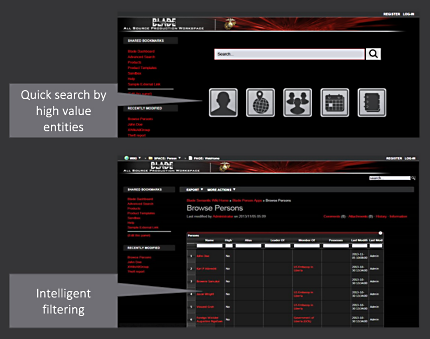Putting powerful analytics into a 'Facebook for terrorists'
Modus Operandi’s semantic technology corrals and analyzes intelligence big data and puts it into a familiar interface.

The current Blade wiki interface allows agents to update and rate information.
A problem with collecting data on potential terrorists is that it can pretty quickly become big data, full of fragmented strands of information on individuals, organizations and activities that can be difficult to connect.
One company working on a solution is Modus Operandi, which is developing what it calls a Facebook for terrorists that would provide users with a familiar interface that draws on a semantically linked trove of information.
Currently in the R&D phase, the app—as yet unnamed—would allow analysts to update information, drop in photos, make comments and even rate the quality of information. “It’s a complement to some of our other technologies,” said Eric Little, the company’s chief scientist.
The app is an offshoot of the company’s Blade semantic wiki, which the Marine Corps has field-tested. The idea is to “provide intelligence analysts with a single, straightforward technology that is similar to what they already know,” Little said.
Many intelligence analysts are young people in a high-stress job, he said. And giving them familiar, easy-to-use technology can take some of the pressure off and make it easier for them to work.
But while a familiar, friendly interface has a definite appeal, the real value of the system comes from its underlying semantic technology, which not only lets analysts make connections but can also make them on its own.
The company’s Wave engine is middleware that operates in the background and can be tailored with subject matter expertise, Little said. It can use that expertise to make advanced queries, perform analysis, make connections and push that information to analysts, rather than having analysts go in and dig it out. For example, if subjects X, Y and Z have a certain type of relationship and are linked to a certain organization or and arms dealer, they could be classified as a high-value target. Members of an organization can be tracked via a data graph that is updated automatically when new information is entered. The system also could link two analysts who might be looking for the same thing.
Wave currently can ingest tens of thousands of documents and create more than 1 million graph-based facts (known as triples) per hour, the company said. And those graphs can be run against an existing graph database that can hold and process more than 2 billion triples as a base graph.
And with Wave, “we’re very careful about data provenance,” tracking information to the source, Little said. If an entry to the system comes from a report, the system will provide a link to the report, even directly to the pertinent information within the report. If an analyst adds or changes anything, the system records the who, what and when of the change.
All that information is then delivered through an interface that could look like a wiki, Google, a customer’s legacy interface or, as in the current project, Facebook.
A key to making those data graphs work, of course, is breaking items into manageable chunks, rather than just assembling a giant picture of everything. That’s part of what the R&D phase is working on, Little said, “because big data is a real problem.”
The company also is starting to work on semantic-based reasoning, writing sophisticated types of logic into the system.
Ultimately, the goal is to be able to keep close track of what can sometimes be loosely based organizations and detect signs of terrorist activities before they come to fruition.
“When the bomb is built and the fuse is lit, it’s too late,” he said. “I want to know when they’re shopping for the components.”
Modus Operandi’s primary military customers are the Navy and Marine Corps, who are helping the company develop the system, but the company also is looking to expand beyond its focus on intelligence. This type of analytics also would have medical applications, such as bio-surveillance on infectious diseases, medical research or watching for bio-terrorism threats, he said.
“It’s about creating the semantic models; content doesn’t matter,” Little said. “The idea is just to solve real problems and stop threats.”




